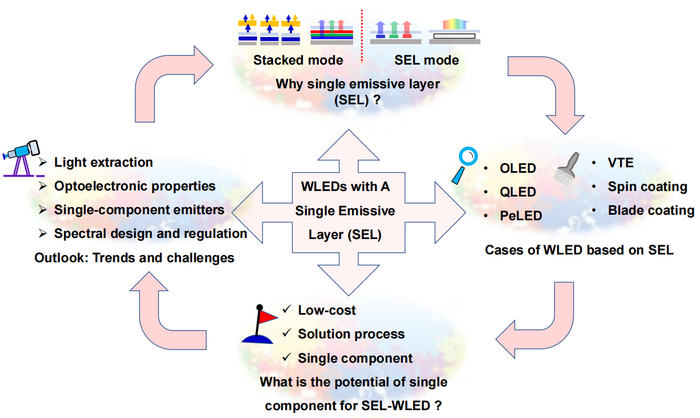Full-electroluminescent white light-emitting diode (WLED) technology is regarded as the best candidate for next-generation solid-state lighting source owing to its lower energy consumption than the current WLED based on blue LED chip and yellow phosphor. Generally speaking, artificial white light source is mixed from multiple monochromatic lights, like red-green-blue-mixed mode (RGB mode) or blue-orange mixed mode (BO mode).
 Emitters and their electroluminescence mechanism in WLEDs; Cases of WLEDs with a single emissive layer; Broad-spectrum emitters’ advances in SEL-WLEDs; Trends and challenges for SEL-WLEDs. Image Credit: Hengyang Xiang, Run Wang, Jiawei Chen, Fushan Li & Haibo Zeng
Emitters and their electroluminescence mechanism in WLEDs; Cases of WLEDs with a single emissive layer; Broad-spectrum emitters’ advances in SEL-WLEDs; Trends and challenges for SEL-WLEDs. Image Credit: Hengyang Xiang, Run Wang, Jiawei Chen, Fushan Li & Haibo Zeng
In order to achieve the mixing of these monochromatic lights, many device architectures have been developed for fabricating efficient white LEDs, e.g., using multilayers of organic fluorescent/phosphorescent materials for WOLED, mixing R-G-B colors of quantum dots for WQLED. However, these approaches are facing many problems on the path to commercial applications, such as complex device structure, voltage-driven color shift and high fabrication cost. In addition, artificial white light source is imitating the sunlight, which spectrum is continuous in the entire visible range and has been considered beneficial to physical and mental health. Therefore, WLEDs based on a single emissive layer (SEL-WLEDs) have always attracted much attention and have made a lot of progress in recent years.
In a new review article published in Light Science & Application, a team of scientists, led by Professor Haibo Zeng from Nanjing University of Science and Technology and Fushan Li from Fuzhou University have reviewed the research progress of SEL-WLEDs and made a summary and outlook for their future development.
In this paper, they reviewed the history and development of SEL-WLEDs in recent years, giving some inspiration to promote its progress in lighting, display and other applications. They introduced the emitters and analyzed the advantages of these emitters in achieving SEL-WLEDs, then reviewed some cases based on the above emitters via vacuum thermal evaporation or solution process. Some notable developments that deserve attention are highlighted in this review owing to their potential for SEL-WLEDs, e.g., perovskite materials. Finally, they looked forward to the development trend of SEL-WLEDs, and proposed the research directions needing to make efforts.
“It is obvious that these single-component emitters have distinct advantages in low cost and simple process, which are the most acceptable in the commercialization process for lighting, display and many other applications. Single-component emitters are able to overcome the obstacles faced by current technology: i) Complicated manufacturing process including the epitaxial growth for GaN based WLEDs and vacuum thermal evaporation with precise doping for WOLEDs; ii) Material cost in current WLEDs owing to the synthesis process (e.g. organic emitters); iii) Difference of emitters involving material stability and emitting stability, e.g. balanced regulation of exciton recombination between different colors, different physical-chemical properties and uncoordinated emitting characteristics between different emitters, etc. Therefore, the single-component emitters with the characteristic of solution process, such as perovskite emitters, provide a feasible path to WLEDs with promising in lower cost, more compatibility, multi-scene adaptability.” the scientists analysis and forecast.